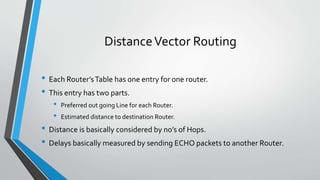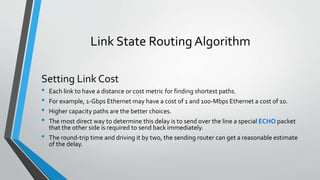Presentation Routing algorithm
- 2. Group Member BASIT HUSSAIN | 2017-CS-126 HAMZA KHAN | 2017-CS-105 IRTEZA HASSAN | 2017-CS-50
- 3. Router • A router has two processes inside it. • One of them handles each packet as it arrives, looking up the outgoing line to use for it in the router tables.This process is forwarding. • The other process is responsible for filling in and updating the routing tables.That is where the routing algorithm comes into play.
- 5. Routing Algorithm • Part of the network layer responsible for deciding which output line an incoming packet should be transmitted on. • If the network uses datagrams internally, this decision must be made a new path for every arriving data packet. • If the network uses virtual circuits internally, routing decisions are made only when a new virtual circuit is being set up.This case sometimes called session routing.
- 6. Routing Example • Routing = building maps and giving directions
- 7. Desired Properties of Routing Algorithm • Correctness • Simplicity • Robustness • Stability • Fairness and Efficiency
- 8. Types of Routing Algorithms • Non-Adaptive or Static Algorithm Routing paths are computed in advance, offline, and downloaded to the routers when the network is booted. It does not respond to failures. • Adaptive or Dynamic Algorithm Change their routing decisions to reflect changes in the topology, and sometimes changes in the traffic.
- 9. Routing Algorithms • Shortest Path Algorithm • Flooding • DistanceVector Routing • Link State Routing • Hierarchical Routing • Broadcast Routing • Multicast Routing • Anycast Routing
- 10. DistanceVector Routing • It’s a Adaptive or Dynamic Algorithm. • Each Router Maintains a table called “Vector”. • Table has the Best Known Distance for Each Routers. • Tables are Updated by exchanging Information with neighbors(Router). • Each Router knows the Best Distance to Reach another Router. • Also Known as Bellman-Ford Routing Algorithm.
- 11. DistanceVector Routing • Each Router’sTable has one entry for one router. • This entry has two parts. • Preferred out going Line for each Router. • Estimated distance to destination Router. • Distance is basically considered by no’s of Hops. • Delays basically measured by sending ECHO packets to another Router.
- 12. A E I J K L H D F B C G 0 12 25 40 14 23 18 17 29 24 21 9 24 36 18 27 7 20 31 20 33 22 0 11 20 31 19 8 30 19 6 0 9 22 14 7 21 28 36 24 22 40 31 19 9 0 22 10 8 20 28 20 17 30 18 12 15 6 10 0 A A I H I I H H K K I - A B C D E F G H L K I J A I H K J Line JA Delay is 8 JI Delay is 10 JH Delay is 12 JK Delay is 6 NewRoutingTableforRouterJ
- 13. Advantages & Disadvantages • Advantages of DistanceVector routing – • It is simpler to configure and maintain than link state routing. • Disadvantages of DistanceVector routing – • It is slower to converge than link state. • It is at risk from the count-to-infinity problem. • It creates more traffic than link state since a hop count change must be propagated to all routers and processed on each router. Hop count updates take place on a periodic basis, even if there are no changes in the network topology, so bandwidth-wasting broadcasts still occur. • For larger networks, distance vector routing results in larger routing tables than link state since each router must know about all other routers.This can also lead to congestion onWAN links.
- 14. Link State Routing Algorithm Why? • DistanceVector Routing algorithm often took too long converge after the network topology changed (due to the count-to-infinity problem).
- 15. Link State Routing Algorithm Idea Behind Link State Routing • This has five parts 1. Discovery its neighbors and learn their network addresses. 2. Set the distance or cost metric to each of its neighbors. 3. Construct a packet telling all it has just learned. 4. Send this packet to and receive packets from all other routers. 5. Compute the shortest path to every other router.
- 16. Link State Routing Algorithm Learning About Neighbors A E A E A A E A A A E A E A A E A A N Broadcast LAN Graph Model
- 17. Link State Routing Algorithm Setting Link Cost • Each link to have a distance or cost metric for finding shortest paths. • For example, 1-Gbps Ethernet may have a cost of 1 and 100-Mbps Ethernet a cost of 10. • Higher capacity paths are the better choices. • The most direct way to determine this delay is to send over the line a special ECHO packet that the other side is required to send back immediately. • The round-trip time and driving it by two, the sending router can get a reasonable estimate of the delay.
- 18. Advantages and disadvantages of link-state routing • Advantage: 1. Routers have direct knowledge of all links in the network and how they are connected. 2. Link-state protocols require less router processor power than distance vector protocols. 3. The topology database eliminates the need for a routing table • Disadvantage: 1. The necessary databases require more memory than a distance vector protocol requires. 2. The complex algorithm requires more CPU time than a distance vector protocol requires.
- 19. Link State Routing Algorithm Building Link State Packet B C D FE A 8 7 3 2 4 5 61
- 20. Link State Routing Algorithm • Sequence Packet: Each packet contains a sequence no., this keep tracks how many times this packet has sent. • Age Packet: Show the life of a packet in Network, after passing by one Hop it is decremented by one. • When to build Link State packets? Build them periodically at regular intervals. Build them when some significant event occurs.
- 21. Link State Routing Algorithm Link State Protocols • IS-IS(Intermediate System – Intermediate System) • OSPF(Open Shortest Path First)
- 22. The End






















